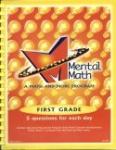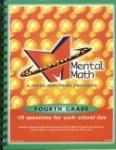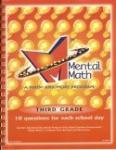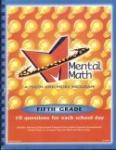Mental Math
Mental Math: First Grade
Problems at this level center around practice in the topics usually introduced at the 1st grade level. In the 5 questions for each day, concepts of numbers, computation, application, and mixed problems are covered. Sample questions chosen at random include the following: Write the number 203. What comes next: 50, 100, 150, ___ ? What month comes after March? A square has ___ sides. Jenny is six months old. Nicki is ten months old. Which one is almost one year old?
Mental Math: Fourth Grade
Problems at this level include a review of 3rd grade math and practice in the topics usually introduced at the 4th grade level. In the 10 questions for each day, concepts of numbers, computation, application, and mixed practice are covered. Sample questions chosen at random include the following: Increase the tens place by one in the number 23,460. What is the area of a square that is 4 feet on a side? What number when multiplied by two becomes 22? AZ, AY, AX, ____. What comes next? If I put five red marbles and one green marble in a bag, what are my chances of picking a red marble?
Mental Math: Third Grade
Problems at this level include a review of 2nd grade math and practice in the topics usually introduced at the 3rd grade level. In the 10 questions for each day, concepts of numbers, computation, application, and mixed practice are covered. Sample questions chosen at random include the following: Draw six circles and shade one-third of the set. Estimate the answer: 490 + 180 is about how much? It is one hour earlier in Chicago than here. Look at the clock and write down the time that it is in Chicago now. What comes next: A1, B2, C3, ___ ? 13,900 - 1,000 = ?
Mental Math: Fifth Grade
Problems at this level include a review of 4th grade math and practice in the topics usually introduced at the 5th grade level. In the 10 questions for each day, concepts of numbers, computation, application, mixed practice, decimals, fractions and percents are covered. Sample questions chosen at random include the following: What number when multiplied by six and divided by three becomes 12? Write seven and four tenths as a mixed number with a decimal. How much time has elapsed from 4:31 a.m. to 7:01 a.m.? 72 people were on the train. 1/8 of them got off at the first stop.




